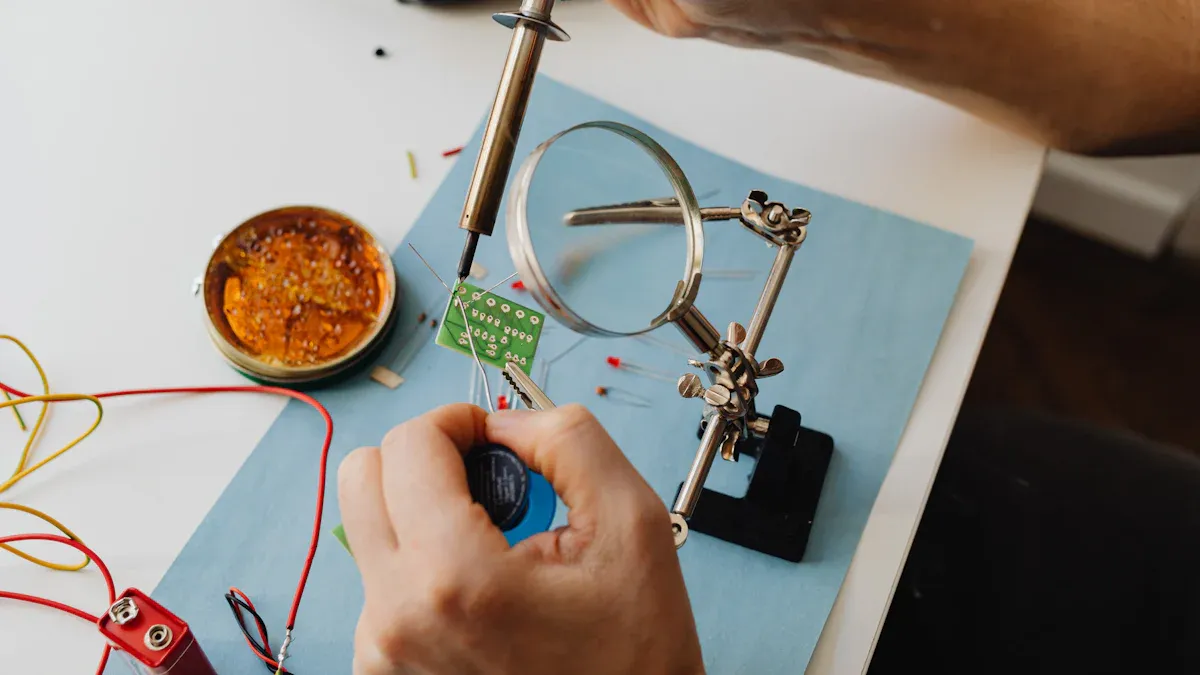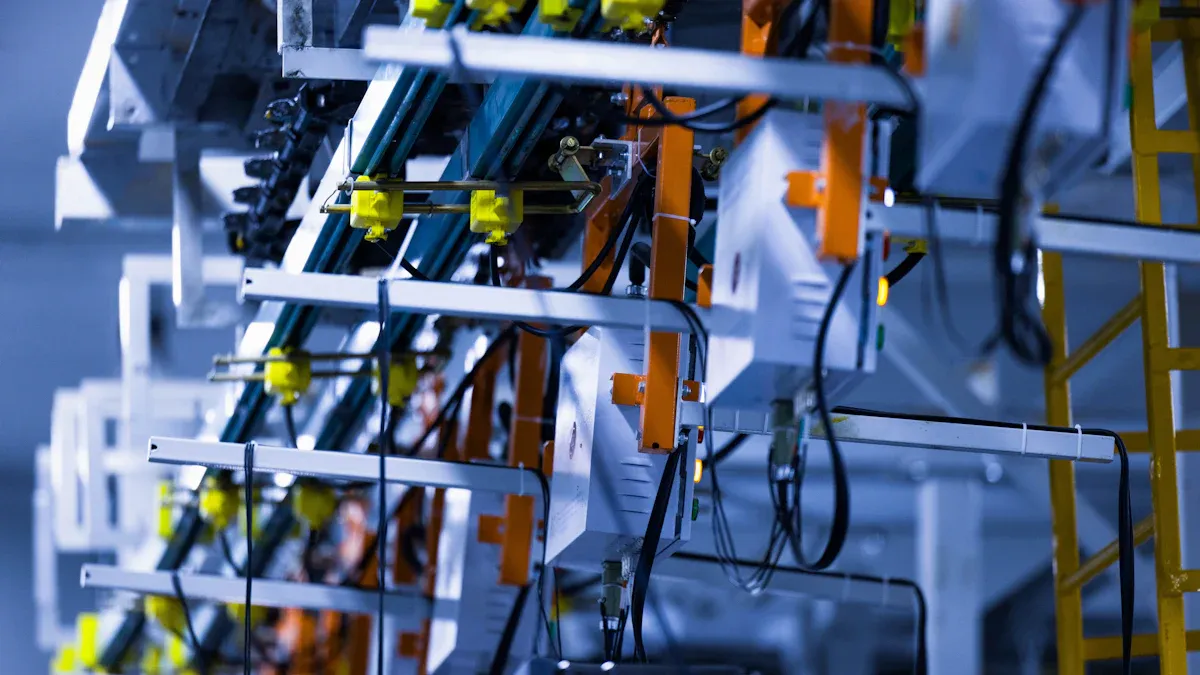
PCBA assembly, which stands for Printed Circuit Board Assembly, makes electronic devices work by attaching parts to a circuit board. This process involves understanding what is PCBA and its components, utilizing careful methods and technology to ensure devices are reliable. New techniques have made the process faster and better. For example:
Electrical problems decreased by 50% with the DMAIC method.
First pass success improved from 95% to 99%, showing better results.
Fewer engines were rejected, helping companies reach their production targets.
These improvements highlight how PCBA assembly transforms materials into functioning, reliable devices.
Key Takeaways
PCBA assembly turns an empty circuit board into a working device by adding parts.
Checking quality is important; tools like Automated Optical Inspection (AOI) find mistakes early to make better products.
Testing makes sure the PCBA works right, making it more reliable and keeping customers happy.
New methods like Surface Mount Technology (SMT) make production faster and cheaper while staying high-quality.
Using industry rules ensures PCBA assemblies are good and meet customer needs.
What is PCBA and Its Components

Definition of PCBA
PCBA means Printed Circuit Board Assembly. It is the process of adding electronic parts to a PCB to make it work. This turns an empty board into a device that powers electronics. Rules from groups like IPC (Institute for Interconnecting and Packaging Electronic Circuits) help ensure good quality. Here are some important standards:
Description | Why It Matters | |
|---|---|---|
IPC-A-610 | Rules for Good Electronic Assemblies | Explains how soldering and assembly should look. |
IPC-2221 | General Rules for PCB Design | Gives tips on materials and how to build PCBs. |
IPC-J-STD-001 | Rules for Soldering Electrical Assemblies | Lists what is needed for soldering and materials. |
These rules make sure PCBAs are high-quality and dependable for many uses.
Key Components in PCBA Assembly
Each PCBA has important parts that work together to do tasks. These parts include:
Resistors: Manage and reduce how much electricity flows.
Capacitors: Hold and release electricity when needed.
Integrated Circuits (ICs): Small devices with many parts for hard tasks.
Connectors: Help parts share power and talk to each other.
New PCBA methods make work faster and more accurate. Machines lower costs and speed up production. Better soldering reduces mistakes. Smaller designs allow tiny, powerful PCBAs. These changes cut costs and help create new products.
Knowing about PCBA and its parts shows how electronics are made. Every part is important for making devices work well and last long.
Key Steps in the PCBA Process

Adding Solder Paste
The first step is adding solder paste to the PCB. A stencil helps spread the paste on areas for components. The paste has tiny solder bits mixed with flux. Flux helps make strong connections during soldering.
Solder Paste Inspection (SPI) is very important here. It checks if the paste is applied correctly to avoid problems. About 75% of Surface Mount Technology (SMT) issues come from bad solder paste printing. SPI finds problems like too little or too much paste. These issues can cause parts to fail. Catching mistakes early improves quality and reduces fixing time.
Placing Components
After adding solder paste, the next step is placing components. You put electronic parts on the PCB where the paste is. This can be done by hand or with machines.
Modern machines use cameras to place parts precisely. They match shapes to ensure parts are in the right spots. Design for Assembly (DFA) helps make layouts better. This saves time and lowers mistakes. These tools make placing parts faster and more accurate, improving PCBA quality.
Reflow Soldering
Reflow soldering attaches the parts to the PCB permanently. The board goes into a reflow oven, which heats it carefully. The heat melts the solder paste, bonding the parts to the board.
The oven must control the heat to avoid damage. It follows a set temperature plan, heating and cooling the board slowly. This ensures the solder hardens properly. Good soldering makes the PCBA strong and reliable, meeting quality standards.
Inspection and Quality Control
Checking and controlling quality is very important for PCBA. It ensures all parts are placed and soldered correctly to avoid mistakes. Both people and machines inspect the boards to find problems early.
A strong quality check system helps keep PCBA production reliable. Using advanced tools and technology ensures products meet customer needs.
Automated Optical Inspection (AOI) is a great tool for quality checks. It uses cameras to spot issues like misplaced parts or bad soldering. Manual checks are slower but can catch small problems machines might miss.
Here are some main benefits of good quality control:
PCBA Quality Assurance: Finding mistakes early ensures industry rules are followed.
PCBA Cost Reduction: Fixing problems early saves money on repairs.
PCBA Customer Satisfaction: Good products make customers happy and build trust.
To get these benefits, inspections should happen at different steps. This helps fix problems before they grow, saving time and effort.
Functional Testing
Functional testing checks if the PCBA works well in real-life situations. It makes sure the assembly meets design plans and works properly.
During this testing, you test how the PCBA performs in normal use. For example, system-level testing checks if all parts work together as one unit. Regression testing ensures updates don’t cause new problems.
Metric/Benefit | Description |
|---|---|
System-Level Testing | Tests the whole PCBA to ensure it works in real conditions. |
Test Cases and Scenarios | Creates tests that mimic normal use to check performance. |
User Experience Testing | Checks how easy and smooth the product is to use. |
Quality Assurance | Finds problems early to avoid costly fixes later. |
Reliability | Makes sure products meet design and safety standards. |
Functional testing improves reliability and keeps customers happy. Products that pass these tests are less likely to break, reducing returns. By doing thorough testing, you can deliver high-quality PCBA assemblies that work great and last long.
Technologies Used in PCBA
Surface Mount Technology (SMT)
Surface Mount Technology (SMT) is a common way to build PCBAs. It places parts directly on the board without drilling holes. This method helps make small and light devices like phones and laptops.
Machines used in SMT are very precise. They use tools like Automated Optical Inspection (AOI) to find mistakes early. AOI helps improve the quality of the boards. SMT also uses smart devices to monitor and improve production in real-time. This makes work faster and reduces errors.
SMT is also better for the environment. Many companies now use lead-free solder and try to create less waste. These steps help protect the planet and follow global eco-friendly goals.
Evidence Description | Details |
|---|---|
Industry 4.0 Integration | Uses smart devices to improve production and reduce errors. |
AI in PCBA | Tools like AOI ensure high-quality boards. |
Eco-Friendly Practices | Lead-free soldering and less waste help the environment. |
Through-Hole Technology (THT)
Through-Hole Technology (THT) was popular before SMT became common in the 1980s. Even now, THT is still useful because of its strong connections. It works by putting part leads through holes in the board and soldering them on the other side.
THT is great for parts that need to handle stress. It is often used in military and space equipment where strength is important. THT connections also survive tough conditions better than SMT ones.
THT is helpful for testing and trying out new ideas. Its parts are easy to solder by hand and can be replaced quickly. This makes it a favorite for engineers working on new projects.
THT creates strong links between board layers.
It is perfect for tough jobs like military and space use.
THT parts are easy to swap during testing.
It handles harsh conditions better, making it more durable.
Using both SMT and THT together gives you the best results. SMT makes small designs, while THT adds strength. Both are important for building reliable PCBAs.
Importance of Inspection and Testing
Ensuring Product Quality
Checking PCBA products is very important for good quality. Quality checks help find mistakes early and keep high standards. Tools like Automated Optical Inspection (AOI) and In-Circuit Testing (ICT) make sure all parts work properly.
Here are some key quality checks:
Quality Check | What It Does |
|---|---|
IQC | Checks materials before production |
First Article Check | Tests each process step |
IPQC | Monitors quality during production |
AOI Testing | Uses cameras to find errors |
In-Circuit Test (ICT) | Tests circuits for problems |
Functional Test (FCT) | Checks if it works as designed |
Reliability Test | Tests how long it will last |
These checks make production faster and cut time by 20%. A study showed a 96% success rate, proving inspections keep quality high.
Identifying and Fixing Defects
Finding defects early stops expensive mistakes. Advanced tests can find problems like bad soldering or misplaced parts. For example, a study used a chi-square test to find high soldering errors. Fixing these issues improved reliability and saved money.
Modern tools are very accurate. Studies show they find 91.1% of defects in PCBA samples. This helps fix problems before they ruin the product.
Enhancing Device Reliability
Reliability tests check if PCBAs work well in real-life conditions. Tests like thermal cycling and high-temperature tests check durability.
Test Type | What It Checks | Where It’s Used |
|---|---|---|
Thermal Cycling Test | Handles big temperature changes | Used in products with extreme temperature shifts |
High-Temperature Life Test | Works well in hot conditions | Important for electronics and industrial tools |
Temperature-Humidity Test | Handles heat and moisture together | Needed for marine or humid environment products |
These tests make sure devices are safe and last longer. For example, a study showed 82.5% accuracy in testing five PCB types. By focusing on testing, you can make reliable products that meet customer needs.
The PCBA process is crucial in making electronics. Each stage, like adding solder paste and testing, ensures high-quality devices. This process helps lower errors, speeds up production, and creates dependable products.
📈 Main Benefits:
Faster and smoother production steps.
Lower costs by reducing mistakes and fixes.
Metric | Description |
|---|---|
Fewer errors mean better quality and higher success rates. | |
Faster Processes | Removing delays and unnecessary steps makes production quicker. |
Cost Reductions | Cutting down on errors and repairs saves money and boosts profits. |
By following these steps, you create strong, reliable devices that satisfy customers.
FAQ
What is the difference between PCB and PCBA?
A PCB is just a plain board with no parts. A PCBA has all the electronic parts added, making it work. Think of a PCB as a blank sheet and a PCBA as a completed drawing.
Why is solder paste important in PCBA assembly?
Solder paste works like glue for electronic parts. It helps stick components to the PCB during heating. Without it, parts won’t stay in place or connect well, causing problems.
Can you reuse components from a failed PCBA?
Yes, some parts can be reused if they are not damaged. But you must test them first to make sure they still work. Reusing parts saves money but needs careful checking.
How does SMT differ from THT?
SMT places parts directly on the board, making devices smaller. THT puts parts through holes, creating stronger connections. SMT is great for small gadgets, while THT is better for tough jobs.
What happens if a PCBA fails functional testing?
If a PCBA fails, tools like AOI or ICT find the problem. The faulty part is fixed or replaced after inspection. Testing ensures only good products are sent to customers.
💡 Tip: Testing often during production helps avoid final product failures.
See Also
Essential Steps In The PCBA Manufacturing Process Explained
Understanding PCBA: Definition And Its Significance Unveiled
The Functionality Of SMT In PCBA Assembly Process